Abstract
This study aims to explore online teaching from the perspective of the cultural-centered model (CCM) of user experience (UX) design and learning preferences (LP) for by investigating in Chinese national universities. A mixed-method approach was used based on the results of a questionnaire survey; results showed that questions mostly reported by students mainly concerned the need for test preparation, such as playback and optimized interactive functions. The need for playback feedback also indicates that teachers are reluctant to turn on the playback function when teaching online, and there are certain pressures and concerns. In terms of interface functions and user interface (UI) design, more students tend to prefer simple and easy-to-operate designs, while neutral colors are the main color choices. In general, under the test-oriented education model, the above phenomenon reflects that the students at national universities in China do not have a significant demand for communication and discussion in online courses, which is related to the overall characteristics of being shy to express their opinions and more concerned and anxious about the pressure of course examinations. For the above phenomenon, the paper discusses the possibility of a teaching platform and proposes four main platform interactions under the curriculum to better improve the UX of online teaching and meet the needs of students. Finally, this study presents that cultural differences and educational background significantly impact online learning preferences. The UX and UI of the teaching platform system should be based on generality, and more attention should be paid to the cultural characteristics and realistic needs of user groups.
1. Introduction
Due to the COVID-19 pandemic since early 2020, VooV Meeting (VM), WeCom (WC), and Ding Talk (DT) have become the main online teaching platforms in Chinese national universities, just as Zoom, Google Classroom and social media platforms such as WhatsApp are the most used online teaching platforms for overseas universities universities. For example, the online teaching usage rate of WhatsApp has reached 84.4%and 87.5% in the research papers of different scholars [1,2]. The findings showed that WhatsApp (34.11%), Zoom (18.6%), and Google Classroom (15.5%) in Indonesian universities [3].
According to statistics from June 2021, online teaching has been implemented in general higher education institutions nationwide since the outbreak of the pandemic. The development of online course platforms has been rapidly promoted, and by the end of February 2022, the proportion of higher education teachers using hybrid (online plus offline) teaching methods had increased from 34.8% before the pandemic to 84.2% [4].
During the COVID-19 pandemic period, online course platforms have been updated to improve the course ecosystem for a better learning experience. This paper focuses on the user experience (UX) design of online teaching platforms and learning preferences (LP) based on the specific cultural and exam-oriented education background of Chinese high education. Given that the phenomenon of “involution” is very serious, this study provides insights that uncover the real attitudes, goals, and behaviors of Chinese national university students and proposes optimization strategies for the design of the online education platform ecosystem to better meet the needs of online teaching.
The main discussion of this article is as follows:
- What kind of feedback and demands from Chinese public university students is there, and how should we refine user experience (UX) to meet the needs of learning preferences (LP)?
- What are the characteristics and reflections of learning preferences (LP) and cultural factors in the design of the teaching platform interface?
Based on the above issues, this article proposes a new online teaching interactive design model: hat is, respecting cultural differences and learning preferences (LP), instead of emphasizing the existing platform exchanges and discussion functions. The advantages of this model are reflected in the aspects of course attendance records, playback, homework submission, and online examinations. The research tries to reveal the potential importance of learners’ cultural backgrounds and learning preferences for online teaching and platform design.
2. Literature Review
Ref. [5] have evaluated UX questionnaires as an approach to explore its appeal and usability. Ref. [6] have analyzed the impact of UX and deeply retrieved users’ requirements over three years. Ref. [7] analyzed the Perceived Usefulness (PU) of technologies and the Perceived Ease of Use (PEOU) of technology for online education. Other research methods for UX are more inclined to the data depiction of users, such as to create personas for a vivid, narrative description of users [8].
Previous studies reported on the architecture of platforms. Ref. [9] clarified and supported users in their choice of the most suitable platform to meet their needs. Ref. [10] proposed Service Oriented Architecture (SOA). Ref. [11] developed an online learning support system using allocation information service architecture. Ref. [12] analyzed the functional construction of different types of online learning platforms.
For Learning Preferences, Ref. [13] demonstrated that equivalent learning activities can be equally effective for online and face-to-face learners. Ref. [14] revealed the possible learning preferences and learning styles of students in online environments. Ref. [15] found that Chinese learners have a preference for learning in a question-raising manner, featured with an obvious answer-seeking tendency aimed at seeking objective answers. Ref. [16] pointed out that Learning Styles have been identified as “learner preferences” rather than a basis for matching instruction. Ref. [17] focused on students’ perception and preference towards online learning and found that students prefer recorded classes with quizzes at the end of each class to improve the effectiveness of learning. Ref. [18] demonstrated that providing instruction based on students’ learning style preferences does not improve learning. Ref. [19] found that students had a preference for in-person learning and rated online courses more negatively than in-person courses.
Furthermore, student-centered education focuses on the function of the course content, enhances learning and provides users with access to online services and services [20]. Online learning works as a temporary alternative due to COVID-19 [21].
In terms of perceived usefulness and perceived ease of use, Ref. [22] developed a theoretical extension of the Technology Acceptance Model (TAM, TAM2, TAM3) that explains perceived usefulness and usage intentions, insight into users’ responses to the information system, and influence on behaviors intention. Adapting to student needs for the students, the inability to maintain a self-disciplined learning attitude is one of the challenges faced by online courses [23]. Research on the use of social media platforms as a collaboration tool, such as Twitter, in the academic environment [24], and use WhatsApp as a Learning tool [25]. Most of the above research on online education platforms are focused on the information service and functional construction but is less related to the design experience and system architecture of online teaching platforms.
UX considered to be crucial, influences the effects of online teaching and learning [26,27,28,29]. UX models are often regarded as a combination of objective and subjective parts [30,31]. In the Chinese context, there is a relative lack of discussion on the UX design of online teaching platforms. A study carried out by ref. [32] on Chinese learners’ preference for learning that is aimed at seeking objective answers. Ref. [33] study focused on the relationship between online instructional design and student learning, and the effectiveness of delivery of online instructional information. Ref. [34] discussed open educational resources (OER) and open educational practices (OEP), and presented a generic OEP framework. Ref. [6] focused on user requirements and experience.
Previous researchers also pointed out several problems in their papers, such as the isolation of teachers and students, insufficient time for course preparation, the discussion function of the platform, and a single model. In particular, the following issues need to be addressed:
- Preliminary research emphasized the discussion platform function in online teaching. After the technical iteration of the teaching platform system, the user-centered system design has been understood as an approach to building a complete and effective product experience [35,36,37]. Ref. [38] presented a User-Centered Design (UCD) approach to develop a system, Ref. [39] described how stories are powerful tools in UX Design, but this research on the above-mentioned design problems did not distinguish the differences between group experiences in different cultural backgrounds. Cross-cultural UX design emphasized Culture models to define dimensions of difference and similarity among user groups [40,41,42,43,44].
- The online teaching platform is not for leisure and entertainment; people just hope to use this online method to replace classroom teaching due to the impact of the epidemic, so they pay more attention to practicality. That is, teaching content and review for examination.
- Under the above circumstances, in the construction of the online teaching platform system and model, the cultural and preference factors play a certain role and affect the user experience (UX).
3. Methodology
The mixed method (qualitative and quantitative) was used in the survey study, which was conducted from (Questionnaire 1 and Questionnaire 2) to 22 October (Questionnaire 3), 2022. Online teaching methods at Chinese national universities have gained unprecedented popularity.
Then this study compared user experience (UX) and learning preferences (LP) of three different SaaS platforms (non-open course repositories): VooV Meeting (VM), WeCom (WC), and DingTalk (DT). As the usage of these three platforms is relatively high for online courses in Chinese national universities, this exploration may help to identify the possible factors and barriers that affect the online course experience and the rationality of platform ecosystems. The purpose of this study is to identify a more suitable interface logic for the characteristics of the student population from a design perspective, to improve the effectiveness of online courses.
The process of this research is divided into three stages: Firstly, the system architectures of online course platforms were compared to understand the logical relationships between the functions of different platforms and their ecosystems. Secondly, UX and effectiveness were evaluated by means of questionnaires and data analysis [26,45,46,47].
Therefore, both objective and subjective factors were considered in the questions set in the questionnaire. Furthermore, in order to obtain effective results that can truly reflect the questionnaire questions, the questionnaires of the three separate surveys were designed using three different types of questionnaire. Questionnaire 1 to Questionnaire 3 had 15 questions each. Questionnaire 1 aims to obtain the experience evaluation of non-design students on the online teaching platform. The content of the questionnaire is defined in the user experience (UX) and learning preferences (LP) in multiple national universities (N = 10) (Table 1).

Table 1.
15 different questions of Questionnaire 1. (Source: information that the researcher obtained via the ”Wenjuanxing” platform).
Questionnaire 2 was designed to evaluate the platform design on the user experience (UX) and learning preferences (LP) of non-design students in different national universities (N = 2); Questionnaire 2 aims to obtain the experience evaluation of design students on the online teaching platform. The content of the questionnaire is defined in the user interface (UI) design and usability (Table 2).

Table 2.
15 different questions of Questionnaire 2 and Questionnaire 3. (Source: information that the researcher obtained via the” Wenjuanxing” platform).
The content of Questionnaire 3 is the same as Questionnaire 2, which aims to form a comparison of the feedback information of the two groups of non-design students and design students. Questionnaire 3 is aimed at the 2022 undergraduate students of environmental art design (four classes), industrial design (two classes), and product design (three classes) at the School of Design of Jiangnan University (N = 1), where the researcher is teaching this semester (2022 autumn semester), were taken as the research subjects of this study.
Finally, the possible influence on the user experience (UX) and learning preferences (LP) of other factors (such as educational and cultural factors) was discussed, such as the faculty and students’ abilities, platform characteristics, course attributes (theoretical and practical courses), teaching mode, and cultural factors.
4. Results and Discussion
An online mix of Questionnaire 1 to Questionnaire 3 ware distributed by Wenjuanxing in different national universities. Questionnaire 1 was forwarded by the teachers of 10 national universities (Including Xi’an University of Science and Technology, Xi’an University of Technology, Xuzhou Normal University, China University of Mining and Technology, Lingnan Normal University, Tongji University, Wuhan Textile University, Nanjing University of Posts and Telecommunications, and Donghua University et al.) to their respective course groups. In total, there were 465 of Questionnaire 1 participants, consisting of 99 males (21.29%) and 366 females (78.71%). In total, 64 copies Questionnaire 2 were distributed, and participants consisted of 16 males (25%) and 48 females (75%) from design students of two national universities. Finally, 260 copies Questionnaire 3 were produced by two combined classes of 2022 undergraduate students in the School of Design of Jiangnan University (national University), the total number of co-classes of the three majors was 260 students (N = 145 + 115), and participants consisteed of 56 males (21.54%) and 204 females (78.46%), reaching a response rate of 100%.
Questionnaire 1 results showed that VM was currently the most popular online course platform among non-resource courses, with 73.65% of the students using it. The percentages of WC and DT were 24.41% and 19.87%, respectively.
Regarding the resource online course platforms, the ranking of the sources used was Tencent Classroom (30.54%), Superstar Learning (20.43%), MOOC (6.02%), Zhihuishu (5.16%), and Xueersi (1.72%). Mainly relying on Tencent’s rich ecological resources, the Tencent Classroom enjoyed a greater familiarity among young students. Students also had a high degree of acceptance and recognition of Superstar Learning due to its access to the resource data of major university libraries. The learners had a certain dependence on the platform ecology, and a complete ecosystem must meet both the teaching needs and the needs of students in multiple directions (Figure 1).
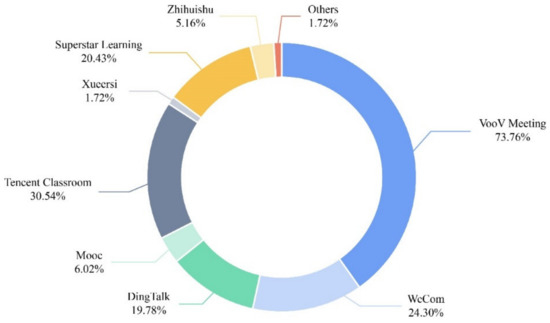
Figure 1.
Distribution and Percentage of Online Course Platforms Recognized by 465 national University Students Based on Questionnaire 1. (Source: information that the researcher obtained via the “Wenjuanxing” platform).
When choosing an online course platform, interface simplicity, real-time interaction, and robust functionality were the three most important factors for national university students, and the percentages of attention were 65.69%, 64.3%, and 53.76%, respectively. These findings reflect the needs of the learners in three dimensions: aesthetic feeling, operation logic, and use functions. Secondly, 39.57% of students paid special attention to privacy and security issues. When participating in online courses, the students usually set audio permissions in advance to avoid turning on cameras and microphones when joining a conference. In addition, the richness and transparency of course resources were more valued by students (Figure 2).
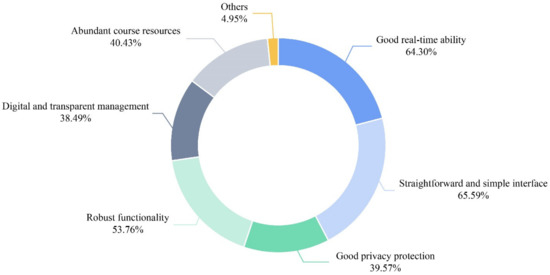
Figure 2.
Analysis of Advantages and Attractiveness of Online Course Platforms by 465 national University Students Based on Questionnaire 1. (Source: The information obtained by the researcher through the Wenjuanxing platform from 465 national university students in different provinces and cities from 13 May to 1 June 2022.).
The main functions of the online courses of the three platforms were compared, and it was found that the functions differentiated from basic online course teaching, including attendance, documents, and photos. As the online conference platforms are not limited to a specific mode but reflect the current situation through multi-functional interconnections, the teaching ecology was extended as a cross-platform in practical teaching (Table 3).

Table 3.
Comparison of Main Functions in Online Courses of Three Platform Architectures. (Source: drawn by the researcher).
According to the feedback from Questionnaire 1 and Questionnaire 2 from various national universities regarding the three online conference platforms, VM, DT, and WC all concentrated on the platform ecology and the integration of their resources. According to a comprehensive analysis of the interfaces of the various platforms, after the meeting was entered, the three platforms of VM, WC, and DT all tried to simulate the scenes of offline teaching in each step (Table 4). The interface design consisted of seven blocks, including the status area, view area, member information area, chat interaction area, functional area, audio setting area, and view switching area, which easily distracted students’ attention from the course.

Table 4.
Feedback on Online Course Platform Experience from Questionnaires 1−3 (drawn by the researcher).
As two online course platforms in the Tencent series, VM and WC have achieved deep synergy in view, status, interaction, and resource functional areas. According to Questionnaire 3, 85% of the design students thought that WC was better than VM on the user experience (UX) after the researcher’s investigation on the WC platform (but it was also reported that the WC platform was mainly used for learning). The interface distribution logic of VM and WC cloud conferences is basically the same, meaning that activities, such as academic lectures and course learning, can be freely switched. The two are integrated into China’s online course platform with the most abundant ecosystem. While DT’s conference mode is relatively clear in course interaction, view switching, and member information area distribution, due to its rich interface functions, its operation is relatively complicated.
For example, in the online live (OL) mode, VM, WC, and DT show the characteristics of their respective systems—the intercommunication between VM and WC is also reflected in the unity of the interface design between the two, which is more concise and easier to operate than the DT interface. However, the two do not support the intervention of external resources and are limited to expansion within the Tencent SaaS product system. Although the DT group OL interface displays the course status and member information, the text interaction, view switching, and audio settings in OL are not sufficiently clear. In summary, as the online course platforms are still trying to build a scene and experience based on the offline classroom, their online advantages and potentials have not been fully realized.
Compared with VM and WC, the advantage of DT is that it can connect to a rich external course ecology, but the variety of system modes increases the complexity of the interface. Thus, it cannot meet the needs of the learners for cross-platform function clarity and operational convenience. According to the chart information displayed in Questionnaire 2, except for the 7.81% of students who were very satisfied with the current online course effect and platform experience, most learners thought that the experience was acceptable (48.44%), which was mainly due to its good usability (35.94%), and more convenient than classroom teaching (26.56%). However, some students believed that the UX was average (32.81%), and even “not very good” (4.69%) or “very bad” (4.69%) because it was not easy to operate (7.81%), or they had psychological resistance to platform learning (3.13%) (Figure 3).
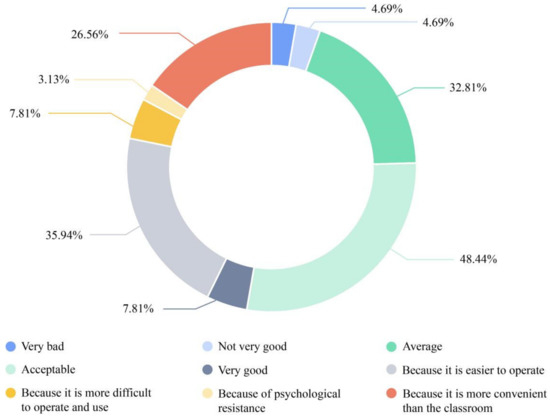
Figure 3.
Feedback on Online Course Experience Effect, Platform Usability, and Influencing Factors from Questionnaire 2. (Source: information that the researcher obtained via the “Wenjuanxing” platform).
In terms of optimizing the functions and interface design of the online course platform, the vast majority of students focused on “ease of use” (good usability), followed by “providing (course) material resources” (48%), “online Q&A” (42%), and video tutorials (41%). In comparison, 40% of non-design students also paid more attention to the aesthetic needs of interface color matching, meaning they were less concerned about “learning points”, “reward mechanism”, and “course classification”. Regarding the aesthetics of the interface, it should also provide certain guidance for use, which can avoid the experiencer’s overthinking or being forced to mute in the process of using course resources. From the comparison of the same question in Questionnaire 2 and Questionnaire 3, the non-design students and design students are mainly concentrated on “ease of use” (63%and 66%, respectively) and “providing material resources” (48%and 52%, respectively), showing high similarity (Figure 4).
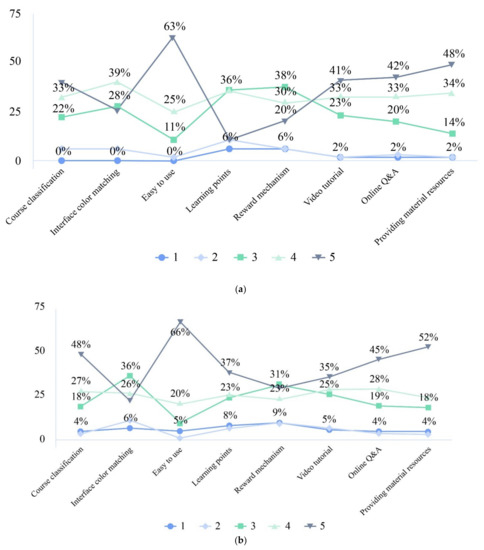
Figure 4.
Comparison with the same question Feedback on Optimizing Functions and Interface Design of Online Course Platforms from Questionnaire 2 and (a) and Questionnaire 3 (b). (1 very unimportant; 2 unimportant; 3 average; 4 important; 5 very important) (Source: information that the researcher obtained via the “Wenjuanxing” platform).
According to the above analysis, and from the perspective of students, the user experience (UX) of VM, DT, and WC are summarized as follows:
- A top-to-bottom, left-to-right page structure is adopted for the interface layout, and the right-hand side is usually the member list or chat area.
- The main part is the screen view and the core function selection area, supplemented by the member information and the chat interaction area.
- The core functions are set around meeting records and teacher-student interactions.
- An obvious phenomenon is that Chinese national university students do not actively communicate on online teaching platforms, which reflects their unwillingness to “show up” in public interactions.
According to the results of students’ preference for the interface design style of the online course platform, the most popular style keywords of the students were “flat” and “minimalist” (41%), “youth and vitality” (44%), and technical sense (41%) in Questionnaire 2. The same question reflects feedback and comparison between the students of non-design and design majors in Questionnaire 2 and Questionnaire 3, who showed more preference for a user interface (UI) design of “flat” and “minimalist” design style (Questionnaire 2 is 41% and Questionnaire 2 is 50%). (Figure 5) This reflects that Chinese national university students prefer more abstract, concise, and well-organized symbolic elements in a user interface (UI) design; therefore, the main body of content should be highlighted in the interface design, and the visual interference brought by the perspective sense, as formed by highlights and shadows, should be abandoned. Instead, geometric color blocks and large rounded chamfers should be used to create a smooth modern design experience, high-brightness colors should be selected, and diverse colors should be used to distinguish different interface ranges to avoid visual boredom.
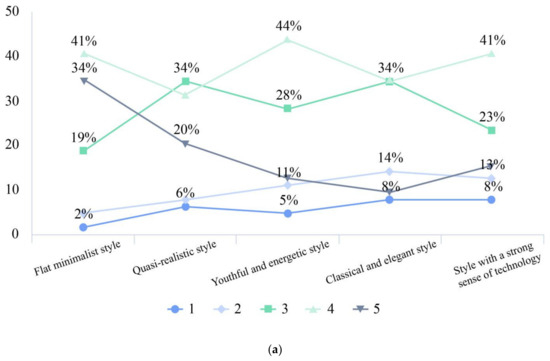

Figure 5.
Comparison with feedback on Interface Design Style Preference Results of Online Course Platforms between Questionnaire 2 (a) and Questionnaire 3 (b). (1 dislike very much; 2 dislike; 3 average; 4 like; 5 like very much).
Improvements to the online course ecosystem have led to more diversified teaching needs. Students’ needs for easy-to-use and personalized options can be grouped into three categories: “preparation needs”, “interaction needs”, and “experience needs”, and their corresponding contents are as follows: “good usability”, “real-time reminder”, “personalized presentation”, “student-teacher interaction”, “results reporting”, “independent communication”, “learning efficiency”, “summary of notes”, “viewing experience”, and “security and privacy” (Figure 6).
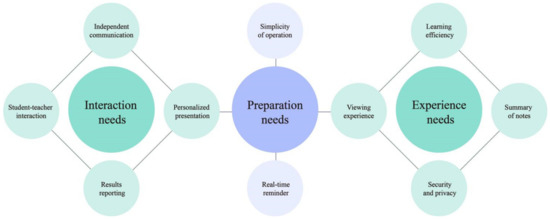
Figure 6.
Classification of Needs for Online Course Platform Experience and Main Contents (drawn by the researcher).
Based on the above classification of needs, the existing functions of the online course platform can be categorized and analyzed. “Simplicity of operation” is the most basic requirement for online courses, and the “ready bell” before the meeting, the reminder to “open the microphone” when speaking is given in silent mode, and “real-time alerts” for information during communication should all follow this need. The function corresponding to “personalized presentation” includes setting the avatar nickname, the beauty filter, and the background of the meeting, and these customized editing effects mainly highlight personal style during communication and presentation. The functions of “teacher-student interaction”, “results reporting”, “learning efficiency”, and “summary of notes” are all fundamental requirements for online courses. The corresponding functions include “interactive annotation”, “sharing window”, “caption display”, “personal document”, and “meeting recording”. In addition, as national university courses are mostly conducted in groups, there are modes for “private chat members” and “discussion group meetings” in the meetings.
Outstanding Issues and aspects of Learning Preference Analysis: According to the responses regarding the platform design questions in Questionnaire 2, the question of optimizing the platform for student learning preferences (LP) of Chinese national universities were recognized by most students, especially the need for pre-test practice (50%). In addition, the questionnaire showed that the respondents were in favor of a reward mechanism to avoid unfair grades due to the lack of an online attendance system (65.63%).
Questionnaire 2 also reported that the platform could be targeted at the student learning preference (LP) of Chinese national universities, especially the demand for the playback function, which was significant. To a certain extent, this finding reflects the importance and anxiety of the design students regarding course examinations. It is also in line with the learning characteristics under the influence of the overall exam-oriented education. Regarding the playback function of live courses, students strongly suggested the ability to browse the live courses repeatedly without time or space constraints (57.81%) (Figure 7). Based on the above feedback information, the main problems are summarized as follows:
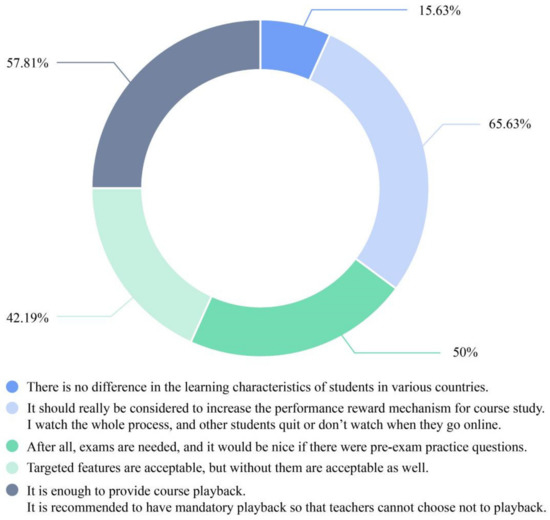
Figure 7.
Feedback from 64 Valid Copies of Questionnaire 2 on Whether to Consider Student Learning Preference (LP) of Chinese national Universities for Platform Optimization. (Source: information that the researcher obtained via the Wenjuanxing platform).
First, the existing thinking for the ecological layout of the online course interface needs to change to “expanding online advantages” from “simulating offline classrooms”, meaning it should pursue the richness of platform resources, expand the functions of actual needs, and eliminate the function duplication phenomenon after integration; for example, in the main view area of the VM and WC cloud conference, there is a chat emoticon feedback bar, as well as a separate pop-up window for an in-meeting chat in the bottom functional area, which makes the functions overlap. The experiencer cannot understand the designer’s intention in use. This will inevitably lead to problems in operation logic and even affect the effect of the course; especially in the live teaching of WC, the function bar (including the dialogue bar) on the right side of the interface occupies a lot of page space and always blocks page information. In the voice call mode of WC, the bottom function key is always on regardless of whether it is selected, and only the “/” symbol on the icon is used to judge whether the function is turned on. Although the interface is consistent in terms of aesthetics, misjudgments can easily occur.
Second is the design problem of the platform interface. The single and tedious design of the interface color tone should be changed. The feedback keywords were mainly flat, youth and vitality, and a strong sense of technology. The layout of the UI focuses on Mapping and logical relationships; for example, in the DT online classroom mode, the UI of the note function is in the upper right corner of the main view, which is far away from the bottom functional area, thus, learners may ignore this function or spend a lot of time searching for the function key, which distracts the attention of the class. In addition, regarding the DT group live broadcast mode, because the interface is too simple, the status bar is at the bottom, and the functional area is at the upper right corner. Thus, the distribution of the two is opposite to other commonly used meeting modes, which may cause learners to feel uncomfortable at the beginning of operation and contradictory at the beginning of use, which will affect their course experience. In the interface design, the concept of “less” is not only the pursuit of simple elements but also paying attention to the visual cognition of Mapping to improve the ease of identification by avoiding cluttered functions and addressing information stacking.
Third, there is a big difference between teachers and students on whether the course live broadcast can be played back. Teachers generally choose to turn off the playback function during a live broadcast due to their concerns (such as fear of potential teaching accidents caused by mistakes), while students want course playback because it can be used for repeated learning. This results in different choices or even opposition between teachers and students due to their needs and functional settings. Due to the different understanding abilities of each student, it is impossible for every student to grasp all the knowledge points in the classroom at the same time. Thus, consolidation and review are needed before the final exam, and there is a strong demand for course playback. (Figure 8) Therefore, the playback function must be taken into consideration during the UI redesign; for example, teachers can set their own clips for playback after class, which can eliminate teachers’ concerns and provide students with opportunities to strengthen their learning after class.
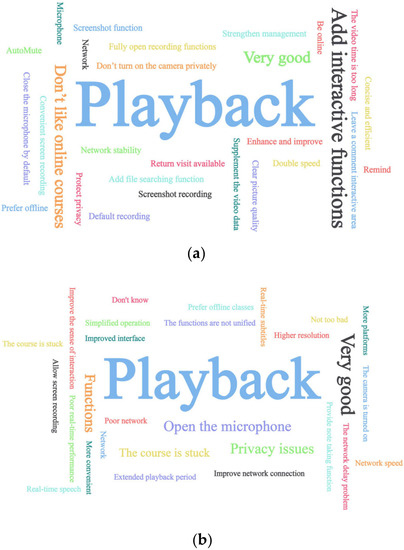
Figure 8.
“Playback” and “Adding Interactive Functions” Dominating Core Vocabulary of Two Cloud Charts ((a) 12–1; (b) 120–2) of Feedback on Platform Improvements and Suggestions in Questionnaire 1. (Source: data obtained by the researcher on 13 May and 1 June 2022, through the Wenjuanxing platform from national university students in different provinces and cities).
In addition to optimizing the basic layout of the interface, there are still three problems in the current platform user experience (UX) design and learning preferences (LP) in terms of function selectivity:
- At the level of course communication and interaction, the course mainly relies on teachers to teach, while the screen demonstration is limited to playing PPT or other instant file demonstrations, which reduces the sense of participation in classroom teaching, and results in no onscreen communication between teachers and students throughout the entire process.
- At the level of emotional design, the interfaces and colors of these three platforms convey a sense of seriousness and indifference, which cannot mobilize the enthusiasm of students to participate in the classroom. Online courses lack the instant interactivity of offline classrooms, and teachers may not be able to grasp the students’ conditions in time and make corresponding adjustments quickly according to their feedback. Thus, they lack control over the teaching progress. At the same time, students are easily fatigued when they face the screen for a long time, which makes it difficult for them to concentrate and affects the teaching effect.
- At the platform ecosystem level, there is too much reliance on the office system of the same platform, and the connection point between online conferences and the entire platform ecosystem is insufficient. For WC and DT platforms, both the cloud conference and the group live broadcast are the only approaches for the output of the teaching content of teachers, and this single-line mode of “class-teaching output-get out of class” keeps students in a state of passive acceptance. Even if they rely on the communication group chat mode on the same platform, it is only basic information transmission rather than the mutual discussions that occur in classroom situations. Therefore, a contact point is needed to effectively link online conferences and the platform ecosystem to stimulate students’ learning autonomy.
5. System Optimization and Usability Analysis
Ref. [48] argue that information and communication technologies (ICTs) are powerful and important tools for advancement and reform in education. According to the study’s findings, the current development trend of the ecosystem of the online education platform is the integration of the open course resource library model and the live teaching model. However, these functional designs focus more on the efficiency and effectiveness of (teaching and learning) behaviors and focus on practical rather than emotional experiences. That is, students are not learning machines but emotional learners. The user cannot design UX by themselves, only creating design features for experience [49]. In terms of the platform ecosystem architecture and design strategies, while pursuing multi-dimensional, deep-level, personalized, and segmented functions, relevant individuals also try to solve the problems of students’ low autonomy in online learning, the lack of classroom participation, and the lack of learners’ collaboration and communication [50].
The ecosystem of the platform should also be considered emotional, affective, experiential, hedonic, and aesthetic factors [27,51]. It is necessary to provide platform design services with more user experience (UX) design and learning preferences (LP) to meet different cultural needs and improve the quality of teaching while meeting the needs of personalized, emotional, stylized, and diversified teaching methods.
5.1. Interface Design for more Inclusive Learning Preferences (LP)
Regarding the topic of student learning preference (LP) of Chinese national universities, as mentioned above, the feedback of Questionnaire 2 was mainly flat, youth and vitality, and a strong sense of technology. It was also reported that “strong practicality” and “simple operation” were the two main features of attention for design students, as 48% of the students deemed those features as “very important”, while 42% of the students hoped to strengthen the platform’s interactivity. Moreover, 41% and 42% of the students hoped that the platform functions could be simple and the interface could be attractive. Therefore, during interface design, it is necessary to make the operation process clearer and more complete to maintain the consistency of the interface aesthetics (Figure 9).
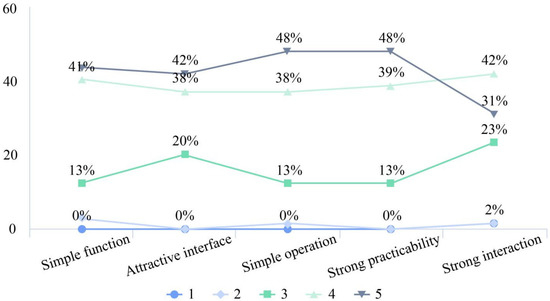
Figure 9.
Feedback on Interface Design Style Preference Results of Online Course Platforms from 64 Valid Copies of Questionnaire 2. (Source: information that the researcher obtained via the “Wenjuanxing” platform).
At present, although the interface designs of these three online course platforms have been improved, such as paying more attention to the relevant functions of the courses and providing real-time feedback information, the basic modes of course implementation are relatively close, and they all focus on PPT presentations. In previous research, the focus was the three types of interaction: teacher-student interaction, student-course content interaction, and student-interface interaction [52]. The first two interaction relationships are mainly aimed at the interactions between the platform and the teacher-student (PTS), which is expressed as the interactive relationship and interaction between teachers and students, as well as the interactive relationship between learners and systems, where the latter refers to the interactive relationship between students during course communication. By combining the feedback information from the three questionnaires and based on the new Cultural-centered Model (CCM) in Online Course Interaction System (OCIS), this research summarized the following four main interactions on the platform system: human-system interaction (HSI), teacher-student interaction (TSI), student-student interaction (SSI), and human-content interaction (HCI) (Figure 10). The new Cultural-centered Model (CCM) reflects the construction of the platform system, from the rich and optimization of the hardware function, need to the combination of “flexible” human factors for comprehensive consideration; even this cultural experience needs are part of the platform system design that cannot be ignored.
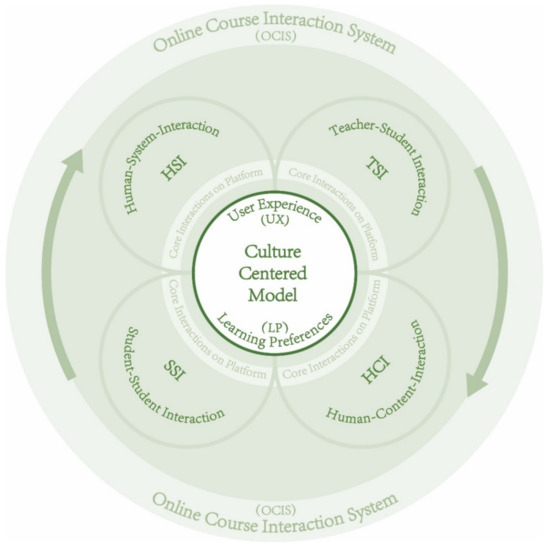
Figure 10.
Cultural-centered Model (CCM) for Online Course Interaction System (OCIS). (source: drawn by the researcher).
The proposal of these four interactive relationships is based on the characteristics of online course learning for students at Chinese national universities who are exam-oriented. Instead of continuing the previous teacher-centered “linear” platform ecological layout, in order to broaden students’ channels of accessing course resources, it is necessary to form a closed-loop system centered on course learning for the connectivity and interaction between various elements.
According to the feedback from Questionnaire 1 to Questionnaire 3, the students paid more attention to the review and assessment of course content. In particular, the need for course playback in HCI was much higher than in other problems, need to reflect more inclusiveness and friendliness in platform interaction design. Therefore, the live content taught by teachers should be consistent with the replayable content required by students, and the core of the platform ecosystem should also be based on the user interface (UI) design relationship generated by the content and habit.
5.2. Optimization Basis and Pain Point Analysis
It is not possible for online course platforms to imitate the mode and effect of offline classroom teaching, as there are significant differences between the two in the field space, their interaction relationships, and experience modes. The advantages of online courses are relatively unrestricted by space, location environment, and clients; thus, the course content should be the core of the interactive form of the course system. Therefore, under the influence of the pandemic, to improve the effectiveness of online teaching, designers must meet personalized and diversified teaching needs based on the advantages of online resources. Based on existing function optimization, the following functional measures target the relevant scenarios.
5.2.1. Design Level: Reflecting Learners’ Characteristics
Chinese national university students in online courses are young people with active thinking, strong curiosity, high learning pressure (competition in grade ranking), and are keen on new technologies and new experiences. At the same time, students believe that online learning methods lack effective binding and are of poor self-discipline; they do not like lectures and prefer to freely control their study time (this may be one of the reasons for requiring replayability). The characteristics of national university students and the possible problems in their experience should be considered in platform design; for example, when the content cannot be reasonably arranged on the platform page, students will easily feel distracted, which will reduce the effectiveness of teaching. Therefore, to build a good platform experience environment for younger learners, designers should study the behavioral characteristics and operational paths of the users, especially for a conceptual framework to support cross-cultural UX design, show a flat-style UI that meets the preferences of youth groups, such as select neutral tones to reflect the combination of fashion and technology [43]. The flat-style UI aims to create a product that causes a pleasant emotional reaction, ref. [53] present “Cultural Personas” in cultural differences.
5.2.2. Experience Level: Incentives and Preference Options
Previous studies have noted that the incentive model in live teaching refers to the use of points, leaderboards, grades, and badges, to apply gamification elements in non-game situations and integrate them into classroom teaching to enrich teaching contents and form and promote students’ immersive learning [54].The current online course platform does not pay enough attention to the design of user motivation and, thus, lacks an effective learning promotion function and point mechanism. In order to promote classroom efficiency, the function of answer sheets can be expanded in classrooms with embedded gamification reward functions, such as points, leaderboards, and badges. From the perspective of emotional interaction, gamification encourages and provides personalized choices, which can enrich the form of classroom teaching and enhance the interactive and visual experience of the classroom and promote learning initiatives.
5.2.3. Platform Level: Curriculum-Centered Ecosystem
The core of building an online course platform ecosystem (OCPECO) is to realize the multi-scenario integration of the ecosystem for the course content in order that teachers and students can enjoy a good user experience (UX) with the course content. For example, after the ecological exchange between VM and WC, one can directly enter TM from WC and vice versa. According to Questionnaire 3, when WC was used by the researcher for teaching, the students reported that the integration and connection between the platform resources made their experience more natural and convenient, which will help teachers and students communicate more efficiently and increase the degree of learner recognition for the online course platform. The degree of recognition is the core factor affecting the participation of Chinese national university students in online courses. When the interaction between teachers and students is insufficient, students will have a lower sense of belonging and recognition [24].
In the above three strategies, optimization suggestions were provided according to design, experience, and system function design at the platform resource level to form a completely closed-loop system. From the design of UI rejuvenation to the emotional interaction of the gamification incentive model in the classroom, such measures can help students to broaden their thinking and improve their enthusiasm for learning, and ultimately improve the quality of teaching.
6. Findings
The survey results show that, in addition to using a single platform for teaching, some national university teachers combined 2–3 platforms (such as Rain Classroom + VM + MOOC). It is undeniable that the effects of online courses are affected by both external and personal factors, which increases the difficulty and uncertainty of objective evaluation of the teaching platform to a certain extent. Felder and Silverman (1988) suggested that active learners in group work share different topics with each other through discussion, but reflective learners prefer to work alone.
6.1. Impact of External Factors
A curriculum-centered model (CCM) optimization scheme is proposed to redefine the interaction relationship of the platform system, which is mainly intended to adapt to the student experience and learning preferences (LP) of Chinese national universities and course learning characteristics; however, other factors that may have an impact on the optimization strategy still need to be considered.
6.1.1. University Factors
As the national universities decide on the platform for online courses, students in different national universities have different experiences with online courses. Under the influence of the pandemic, the choices of online office platforms in various national universities have different office ecosystems. Thus, the derived conference platforms are also different. Therefore, under the influence of university-level courses, students have no choice of course learning platforms, so they are always in a relatively passive learning state.
6.1.2. Platform Factors
The ecosystems of platforms used for online courses will be further opened with coordinated development and rely on mutual links and shared platforms within the ecosystems to obtain the full experience of the course system. At present, the live group mode of WC and DT does not limit the number of viewers. It provides an intersection for some functions, which tends to cause continuous trial and error in use, thus, affecting the experience of online courses.
6.1.3. Cultural Factors
Due to cultural and other factors, Chinese national university students are often ashamed to express their opinions and problems in a course group, and they lack private communication with teachers during course learning, which makes it difficult to achieve online communication between teachers and students in the actual learning process. Therefore, it is necessary to consider the impact of cross-cultural UX design factors on online teaching.
6.1.4. Educational Factors
Affected by the overall exam-oriented education and training model, Chinese national university students pay more attention to reviewing the main points of the exam in their online course study rather than being interested in the full content of the course knowledge. Although the attention and demand for the course content are obvious, they are basically to cope with the final exam. Due to the strict attendance system, the enthusiasm of the students attending the class is relatively insufficient, and it is difficult to recognize the teaching effect of the online course.
6.2. Impact of Personal Factors
6.2.1. Self-Control Factors
Online courses may make students with weak self-control unable to devote themselves to the whole process of the live broadcast, especially if they feel: “If I am distracted in class, I can watch the replay after class to make up for it”. There is a conflict between students’ preference for playback and teachers’ concerns about the teaching content, and teachers will likely insist on the original teaching mode (mainly lecturing on the teaching topics and not replaying them). Thus, there will continue to be issues and student appeals in the three questionnaires.
6.2.2. Unsustainable Factors of Incentives
Although an incentive mechanism can activate the learning behavior of participants, the setting of too many external motivations, such as points, badges, and rankings, may increase the cognitive load of students, blur their internal motivation for learning, and fail to correct their learning attitude. Once continuous motivational behaviors are lost in teaching, students will soon lose interest, resulting in unsustainable learning behaviors under the incentive mechanism.
6.2.3. Impact of Pressure from Other Courses
Although the integration of resources on multiple platforms enables the free switching of multiple scenarios between various ecosystems, students’ extended learning is often affected by the pressure of other coursework, meaning that the relationship between learners and resource content cannot be achieved. The main content still relies on teachers’ lectures and instant sharing of course groups. Otherwise, students may not have time to access learning resources.
7. Conclusions and Implications
This study found that, although the current ecosystem of the online teaching platform of Chinese national universities already meets the general functional requirements of course teaching, there are still problems that tend to persist from the Universal model to the personalized cultural model. The results show that in the construction of an ecosystem, the practical function is important, but the factors of culture and preference also deserve attention.
In particular, the interface design of the online teaching platforms for cross-cultural UX design experience, the emphasis on the neutral color of the interface, and the simplicity of the UI should adapt to the student learning preference (LP) of Chinese national universities. In terms of platform functions, the playback requirements reflect the anxiety of university students regarding exam preparation, meaning the common cultural factors of the general unwillingness to be the first to communicate and interact, which must also be considered in the construction of platform interaction in the future. Thus, this study proposed four curriculum-centered model (CCM) interrelated interaction architectures to replace the previous linear model with a closed loop to take advantage of the online platform, create a new ecosystem of course learning, and avoid the experience effect of imitating offline classroom teaching.
Finally, the curriculum-centered model (CCM) services for different cultural groups need to consider diverse cultural groups and respect. The problem is worthy of further discussion for user experience (UX) design and learning preferences (LP) in Chinese national universities in order to realize the ecosystem of an online course platform that integrates course teaching, resource sharing, and self-learning. The results of this study will provide a reference to the Chinese educational research on online learning preferences.
Author Contributions
Conceptualization, M.W.; methodology, M.W.; software, M.W. and Z.Z.; validation, M.W.; formal analysis, M.W.; investigation, M.W.; resources, M.W.; data curation, M.W.; writing—original draft preparation, Z.Z.; writing—review and editing, M.W.; visualization, M.W. and Z.Z.; supervision, M.W.; project administration, M.W.; funding acquisition, M.W. All authors have read and agreed to the published version of the manuscript.
Funding
This research received no external funding.
Institutional Review Board Statement
Not applicable.
Informed Consent Statement
Not applicable.
Data Availability Statement
The data supporting this study are consistent with the content of the Chinese questionnaire results, and available from the author.
Conflicts of Interest
The authors declared no potential conflicts of interest with respect to the research, authorship, and publication of this article.
References
- Faizah, U.; Ambarwati, R.; Rahayu, D.A. From offline to online learning: Various efforts to secure the learning process during COVID-19 outbreaks. J. Phys. Conf. Ser. 2021, 1747, 12002. [Google Scholar] [CrossRef]
- Putriyanti, C.E.; Retnani, C.T. Correlation between Knowledge of Online Learning Methods and Students’ Motivation During the COVID-19 Pandemic. J. Kesehat. 2022, 11, 74–84. [Google Scholar]
- Tauhidah, D.; Jayanti, U.N.A.D.; Rahmasiwi, A.; Pamungkas, R.; Saifulloh, A. Utilization of e-learning platforms by lecturers during the COVID-19 pandemic in Indonesia. JPBI J. Pendidik. Biol. Indones. 2021, 7, 198–207. [Google Scholar] [CrossRef]
- The Official Website of the Ministry of Education of China. Available online: http://www.moe.gov.cn/fbh/live/2022/54324/sfcl/202203/t20220329_611591.html (accessed on 1 May 2022).
- Lohse, A.; Aust, A.; Röder, J.; Bullinger, A.C. Interdisciplinary Adaptation and Extension of the User Experience Questionnaire for Videos in Learning Environments. In Proceedings of the 20th Congress of the International Ergonomics Association (IEA 2018), Florence, Italy, 26–30 August 2018; pp. 789–798. [Google Scholar]
- Chen, T.; Peng, L.; Jing, B.; Wu, C.; Yang, J.; Cong, G. The impact of the COVID-19 pandemic on user experience with online education platforms in China. Sustainability 2020, 12, 7329. [Google Scholar] [CrossRef]
- Rizun, M.; Strzelecki, A. Students’ acceptance of the COVID-19 impact on shifting higher education to distance learning in Poland. Int. J. Environ. Res. Public Health 2020, 17, 6468. [Google Scholar] [CrossRef]
- Gualtieri, M. Best Practices in User Experience (UX) Design. Design Compelling User Experiences to Wow Your Customers. 2009, pp. 1–17. Available online: https://web.uchile.cl/DctosIntranet/05UsabilidadExperienciaUsuario/BuenasPracticas/BestPracticesUserExperience.pdf (accessed on 1 June 2022).
- Ouadoud, M.; Chkouri, M.Y.; Nejjari, A.; El-Kadiri, K.E. Exploring a Recommendation System of Free E-learning Platforms: Functional Architecture of the System. Int. J. Emerg. Technol. Learn. 2017, 12, 219–226. [Google Scholar] [CrossRef]
- Fajar, A.N.; Nurcahyo, A.; Sriratnasari, S.R. SOA system architecture for interconected modern higher education in Indonesia. Procedia Comput. Comput. Sci. 2018, 135, 354–360. [Google Scholar] [CrossRef]
- Zhao, Y.; Shan, S. Online learning support service system architecture based on location service architecture. Mob. Inf. Syst. 2021, 2021, 6663934. [Google Scholar] [CrossRef]
- Wang, J.; Yu, X. Online Learning Platforms during the Pandemic: Application Status and Developments. In Proceedings of the Society for Information Technology & Teacher Education International Conference, Shanghai, China, 11 April 2022; pp. 211–220. [Google Scholar]
- Neuhauser, C. Learning style and effectiveness of online and face-to-face instruction. Am. J. Distance Educ. 2002, 16, 99–113. [Google Scholar] [CrossRef]
- Alper, Y.G.A. Learning preferences and learning styles of online adult learners. Int. Educ. J. 2004, 4, 270–278. [Google Scholar]
- Zhang, Z.; Huang, R.A. Comparative Research on the Online Question Raising Manner between Chinese and British Learners. Mod. Distance Educ. Res. 2009. Available online: http://en.cnki.com.cn/Article_en/CJFDTOTAL-XDYC200905014.htm (accessed on 17 June 2022).
- Newton, P.M. The learning styles myth is thriving in higher education. Front. Psychol. 2015, 2015, 1908. [Google Scholar] [CrossRef] [PubMed]
- Muthuprasad, T.; Aiswarya, S.; Aditya, K.S.; Jha, G.K. Students’ perception and preference for online education in India during COVID-19 pandemic. Soc. Sci. Humanit. Open 2021, 3, 100101. [Google Scholar] [CrossRef] [PubMed]
- Rogowsky, B.A.; Calhoun, B.M.; Tallal, P. Providing instruction based on students’ learning style preferences does not improve learning. Front. Psychol. 2020, 11, 164. [Google Scholar] [CrossRef] [PubMed]
- Price Banks, D.; Vergez, S.M. Online and In-person learning preferences during the COVID-19 pandemic among students attending the City University of New York. J. Microbiol. Biol. Educ. 2022, 23, e00012-22. [Google Scholar] [CrossRef]
- Ehlers, U.D.; Pawlowski, J.M. Quality in European E-Learning: An Introduction; Springer: Berlin/Heidelberg, 2006; pp. 1–13. [Google Scholar]
- Almahasees, Z.; Mohsen, K.; Amin, M.O. Faculty’s and students’ perceptions of online learning during COVID-19. Front. Educ. 2021, 6, 8470. [Google Scholar] [CrossRef]
- Venkatesh, V.; Davis, F.D. A model of the antecedents of perceived ease of use: Development and test. Decis. Sci. 1996, 27, 451–481. [Google Scholar] [CrossRef]
- Young, S. Student views of effective online teaching in higher education. Am. J. Distance Educ. 2006, 20, 65–77. [Google Scholar] [CrossRef]
- Jones, A. How Twitter Saved My Literature Class: A Case Study with Discussion. Cut.-Edge Technol. High. Educ. 2011, 3, 91–105. [Google Scholar]
- Aduba, D.E.; Mayowa-Adebara, O. Online platforms used for teaching and learning during the COVID-19 era: The case of LIS students in Delta State University, Abraka. Int. Inf. Libr. Rev. 2022, 54, 17–31. [Google Scholar] [CrossRef]
- Ardito, C.; Lanzilotti, R.; Sikorski, M.; Garnik, I. Can evaluation patterns enable end users to evaluate the quality of an e-learning system? An exploratory study. In Proceedings of the 8th International Conference (UAHCI 2014), Heraklion, Greece, 22 June 2014; pp. 185–196. [Google Scholar]
- Maslov, I.; Nikou, S.; Hansen, P. Exploring user experience of learning management system. Int. J. Inf. Learn. Technol. 2021, 38, 344–363. [Google Scholar] [CrossRef]
- Nakamura, W.; Marques, L.; Rivero, L.; Oliveira, E.; Conte, T. Are generic UX evaluation techniques enough? A study on the UX evaluation of the edmodo learning management system. Braz. Symp. Comput. Educ. 2017, 28, 1007. [Google Scholar]
- Jeong, H.Y.; Yi, G.; Park, J.H. A service composition model based on user experience in Ubi-cloud comp. Telecommun. Syst. 2016, 61, 897–907. [Google Scholar] [CrossRef]
- Flores, J.L. Determining the User Experience Level of Operating Computer Systems in the Central Bank of Mexico; Massachusetts Institute of Technology, System Design and Management Program: Cambridge, MA, USA, 2019; Available online: https://dspace.mit.edu/handle/1721.1/122391 (accessed on 12 May 2022).
- Vermeeren, A.P.O.S.; Law, E.L.C.; Roto, V.; Obrist, M.; Hoonhout, J.; Väänänen-Vainio-Mattila, K. User experience evaluation methods: Current state and development needs. In Proceedings of the 6th Nordic Conference on Human-Computer Interaction: Extending Boundaries, Reykjavik, Iceland, 16 October 2010; pp. 521–530. Available online: https://dl.acm.org/doi/10.1145/1868914.1868973 (accessed on 17 May 2022).
- Zhang, Z.; Han, Z. Students’ Conceptions of Online ESL Education in Chinese HE: A Phenomenographic Study. In Proceedings of the 2009 International Conference on E-Learning, E-Business, Enterprise Information Systems, and E-Government, Hong Kong, China, 28 December 2009; pp. 267–270. [Google Scholar]
- Bao, W. COVID−19 and online teaching in higher education: A case study of Peking University. Hum. Behav. Emerg. Technol. 2020, 2, 113–115. [Google Scholar] [CrossRef]
- Huang, R.; Tlili, A.; Chang, T.W.; Zhang, X.; Nascimbeni, F.; Burgos, D. Disrupted classes, undisrupted learning during COVID-19 outbreak in China: Application of open educational practices and resources. Smart Learn. Environ. 2020, 7, 1–15. [Google Scholar] [CrossRef]
- Norman, D.A. Cognitive engineering. In User Centered System Design; CRC Press: Boca Raton, FL, USA, 1986; Volume 31, p. 61. [Google Scholar]
- Bannon, L.J. “20 years a-growing”: Revisiting from human factors to human actors. In Reframing Humans in Information Systems Development; Springer: Berlin/Heidelberg, Germany, 2010; pp. 181–188. Available online: https://link.springer.com/chapter/10.1007/978-1-84996-347-3_11#citeas (accessed on 26 May 2022).
- Lynch, P.J.; Horton, S. Web Style Guide: Foundations of User Experience Design; Yale University Press: New Haven, CT, USA, 2016. [Google Scholar]
- Abras, C.; Maloney-Krichmar, D.; Preece, J. User-centered design. In Encyclopedia of Human-Computer Interaction; Bainbridge, W., Ed.; Sage: Thousand Oaks, CA, USA, 2004; Volume 37, pp. 445–456. [Google Scholar]
- Gruen, D.; Rauch, T.; Redpath, S.; Ruettinger, S. The use of stories in user experience design. Int. J. Hum.-Comput. Interact. 2002, 14, 503–534. [Google Scholar]
- Marcus, A. Cross-cultural user-experience design. In Proceedings of the 4th International Conference (Diagrams 2006), Stanford, CA, USA, 28–30 June 2006; pp. 16–24. [Google Scholar]
- Majrashi, K.; Hamilton, M.; Uitdenbogerd, A.L. Cross-platform cross-cultural user experience. In Proceedings of the 30th International BCS Human Computer Interaction Conference (HCI), Bournemouth, UK, 11−15 July 2016; pp. 1–13. [Google Scholar]
- Souza, T.R.C.B.; Bernardes, J.L. The influences of culture on user experience. In Proceedings of the 8th International Conference (CCD 2016), Toronto, ON, Canada, 17–22 July 2016; pp. 43–52. [Google Scholar]
- Chessum, K.B. A Conceptual Framework to Support Cross-Cultural User Experience Design for Web Search. 2021. Available online: http://hdl.handle.net/10547/624931 (accessed on 21 May 2022).
- Alexander, R.; Thompson, N.; McGill, T.; Murray, D. The influence of user culture on website usability. Int. J. Hum.-Comput. Stud. 2021, 154, 102688. [Google Scholar] [CrossRef]
- Lewis, J.R. Usability testing. In Handbook of Human Factors and Ergonomics; Wiley & Sons: Hoboken, NJ, USA, 2006; Volume 12, p. 30. [Google Scholar]
- Riihiaho, S. Usability testing. In The Wiley Handbook of Human Computer Interaction; Wiley & Sons: Hoboken, NJ, USA, 2018; Volume 1, pp. 255–275. [Google Scholar]
- Lewis, J.R.; Sauro, J. Usability and user experience: Design and evaluation. In Handbook of Human Factors and Ergonomics; John Wiley & Sons: Hoboken, NJ, USA, 2021; pp. 972–1015. Available online: https://onlinelibrary.wiley.com/doi/10.1002/9781119636113.ch38 (accessed on 28 May 2022).
- Butt, R.; Siddiqui, H.; Soomro, R.A.; Asad, M.M. Integration of Industrial Revolution 4.0 and IOTs in academia: A state-of-the-art review on the concept of Education 4.0 in Pakistan. Interact. Technol. Smart Educ. 2020, 17, 337–354. [Google Scholar] [CrossRef]
- Rogers, M.P.; Abell, S.; Lannin, J.; Wang, C.Y.; Musikul, K.; Barker, D.; Dingman, S. Effective professional development in science and mathematics education: Teachers’ and facilitators’ views. Int. J. Sci. Math. Educ. 2007, 5, 507–532. [Google Scholar] [CrossRef]
- Kop, R.; Fournier, H.; Mak, J.S.F. A pedagogy of abundance or a pedagogy to support human beings? Participant support on massive open online courses. Int. Rev. Res. Open Distrib. Learn. 2011, 12, 74–93. [Google Scholar] [CrossRef]
- Hassenzahl, M.; Tractinsky, N. User experience-a research agenda. Behav. Inf. Technol. 2006, 25, 91–97. [Google Scholar] [CrossRef]
- Parveen, S. Perception of Prospective Teachers towards the Use of Online Teaching Platform for school Practice teaching during Lockdown. I-Manag. J. Sch. Educ. Technol. 2021, 17, 23–31. [Google Scholar]
- Lachner, F.; Saucken, C.; Mueller, F.F.; Lindemann, U. Cross-cultural user experience design helping product designers to consider cultural differences. In Proceedings of the 7th International Conference (CCD 2015), Los Angeles, CA, USA, 2–7 August 2015; pp. 58–70. [Google Scholar]
- Pena-Levano, L.M.; Melo, G. Adaptation of Teaching Strategies During the COVID-19 Pandemic. Appl. Econ. Teach. Resour. 2022, 4, 12–33. [Google Scholar]
Publisher’s Note: MDPI stays neutral with regard to jurisdictional claims in published maps and institutional affiliations. |
© 2022 by the authors. Licensee MDPI, Basel, Switzerland. This article is an open access article distributed under the terms and conditions of the Creative Commons Attribution (CC BY) license (https://creativecommons.org/licenses/by/4.0/).